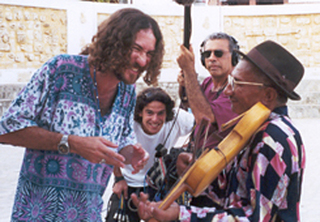SCHAUMLOEFFEL, Marco Aurelio. The African influence on Brazilian Music. Daily Graphic, Accra, v. 149132, p. 14 – 14, 21 maio 2004.
The African influence on Brazilian Music
To think of Brazilian Music without the African influence is simply impossible. The big melting pot Brazil has one of it roots in the African Continent. The contribution of the African element in Brazilian music is vast. Very important influences are the polyrhythmic variations and cadences, which brought, together with the Portuguese and Europeans melodies, new, unexpected creations. The combination of elements of different cultures is responsible for the typical Brazilian music styles like samba, gafiera, choro, pagode, maxixe, maracatu, forró, frevo, embolada, coco (dancing and singing on the beach), lundu (brought by the southern African tribe Bantos) and the MPB (Música Popular Brasileira).
A lot of percussion instruments were brought from Africa to our country or new ones created by Afro-Brazilians. We have various drums with different sounds. The general name for this kind of drums in Brazil is atabaque. Other instruments are the ganzá, a type of rattle-box, the marimba (xylophone with wooden slats) and the cuíca, a type of small drum with a rod in the inside, that produces a strident sound, when vibrated with the palm of the hands, just to quote a few amongst them of African origin.
The fetishists ritual chants, dramatic dances like Congos, Congadas and Quilombos, the nasal twang in the Brazilian singing voice, some choreographic steps are also Afro-Brazilian musical manifestations.
Drumming, singing and dancing were certainly the first manifestations of the cultural treasure that the Africans brought to Brazil. Already in the year 1610, just a Century after the discovery of Brazil by the Portuguese, it is possible to read a report about an orchestra of 30 Africans musicians in Brazil. The great poet Mário de Andrade refers to the African music as the “pererequice rítmica dos africanos”, i.e. “the vibrating (like a tree frog) rhythm of the Africans”. In the USA they created another very important style for the History of the development of music: the jazz.
Samba is our national product. It comes from “semba” in the Banto language (southern Africa), what means dance and clap the hands in a circle. Apart from the big samba-party in the Sambódromo of Rio de Janeiro (a commercial and nowadays more for tourism purposes street Carnival celebration), the Carnival celebration is a huge democratic ball-room or street party in Brazil, where everybody can take part, sing, dance and enjoy the biggest national celebration, commemorated 40 days before of Easter. The five days of joy and fun start on Friday evening and end on Wednesday at noon. All types of dresses are allowed, from masks and plumes to long white dresses or simply beach shorts and t-shirts. In cities like Rio, São Paulo and Porto Alegre big samba academies, that we call samba schools, present every year a new parade. Each samba school chooses a theme to present, the choice is free, but it is normally an up-to-date choice about politics, environment, general Brazilian reality or an homage to a very important person of the present days or of the past.
In Ghana, I was surprised in the first days of my stay here, when I listened to music. I could find something like Cuban music in it. Researching and reading about it, I knew that in the 1960s and 1970s the West African pop music was influenced by Latin styles. So music is an intercultural manifestation. The band Osibisa recorded in 1976 the famous “Coffee song”, in which they mention Brazil.
One of the symbolic examples of the presence of the African roots in Brazilian Music is our present Minister of Culture, the famous musician Gilberto Gil. He is nowadays together with other Afro-Brazilians like Milton Nascimento, Daúde, Martinho da Vila, Sandra de Sá, Djavan, Jorge Aragão, Robertinho Silva, Jorge Ben amongst many others, proof that we would have only poor developed Brazilian music without African blood and rhythm in our veins. Throughout our History of music we have plenty famous and representative examples of Afro-Brazilians, who wrote decisive lines in the Brazilian music.
By the way: Ghanaians like to tell me that they like so much the Brazilian music, principally salsa and lambada. These types of music are not from Brazil, but this is another story.
Marco Aurelio Schaumloeffel
Brazilian Lecturer in Ghana
Source: Marco
